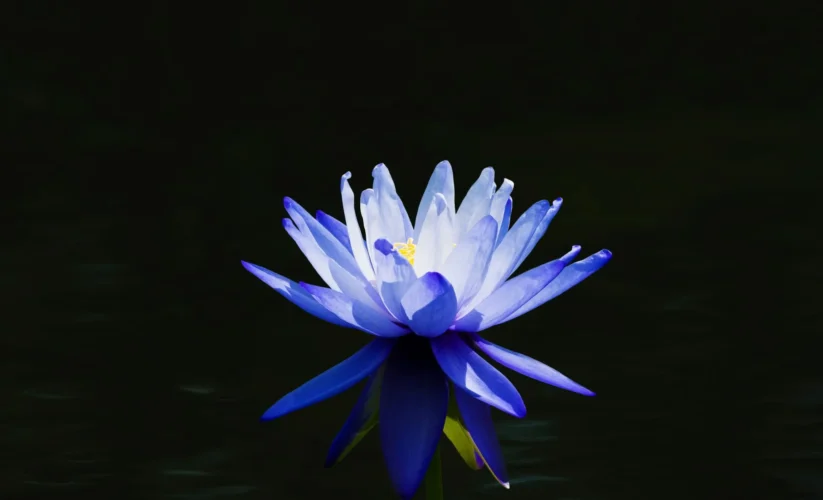
What is the Mystique Behind the Blue Lotus Flower
In botanical wonders, few captivate the imagination quite like the blue lotus flower. Revered for its ethereal beauty and rich cultural significance, this mystical bloom has intrigued scholars, artists, and spiritual seekers for millennia. Let us embark on a journey to unravel the secrets and splendor of the blue lotus flower.
Origins and Symbolism of Blue Lotus Flower
The blue lotus, scientifically known as Nymphaea cerulean, traces its origins to ancient Egypt, where it held profound symbolic and religious significance. In tomb paintings, hieroglyphics and temple carvings The blue lotus symbolized fertility, health and the cycle of life. Egyptians believed that the flower’s ability to emerge from muddy waters and bloom anew each day mirrored the journey of the sun across the sky and the soul’s journey through the afterlife.
Beyond Egypt, the blue lotus found its way into the cultural tapestries of various civilizations across Asia, including India, China, and Thailand. In Hindu and Buddhist traditions, the lotus is revered as a sacred symbol of purity, enlightenment, and spiritual awakening. Its serene presence in art and literature reflects a profound appreciation for the harmony between humanity and nature.
Botanical Characteristics
The blue lotus belongs to the family Nymphaeaceae. It is native to regions of Africa and Asia, where it thrives in shallow freshwater habitats such as ponds, lakes, and slow-moving streams. Characterized by its striking blue or blue-violet petals and elegant, round leaves, the blue lotus exudes an aura of tranquility and grace.
Botanically, the blue lotus is a perennial aquatic plant with rhizomatous roots that anchor it to the sediment below. Its floating leaves, known as lily pads, provide shade and habitat for aquatic creatures. At the same time, its exquisite flowers emerge delicately above the water’s surface, attracting pollinators with their subtle fragrance and vibrant hues.
Ethnobotanical and Medicinal Uses

Throughout history, the blue lotus has been revered for its aesthetic appeal and its purported medicinal and psychoactive properties. In ancient Egypt, the flower was prized for its aphrodisiac qualities and was often steeped in wine or brewed into teas for ceremonial and therapeutic purposes.
The psychoactive effects of the blue lotus are attributed to compounds such as aporphine and nuciferine, which act as mild sedatives and mood enhancers. In traditional medicine systems such as Ayurveda and Traditional Chinese Medicine (TCM), preparations made from the blue lotus have alleviated anxiety, promote relaxation, and enhanced dream recall.
While scientific research on the medicinal properties of the blue lotus is limited, anecdotal evidence suggests that it may offer potential benefits for stress relief, sleep disorders, and overall well-being. However, caution should be exercised, as consuming blue lotus products may interact with certain medications or adversely affect some individuals.
Cultural Significance and Ritual Practices
In addition to its medicinal and symbolic importance, the blue lotus flower is central to various cultural rituals and spiritual practices. In Hinduism, the lotus flower is associated with deities such as Vishnu, Lakshmi, and Saraswati, symbolizing divine beauty, abundance, and wisdom.
In Ancient Egypt, the blue lotus was revered as a symbol of divine revelation and spiritual enlightenment. Priests and priestesses often used it in religious ceremonies and rituals to induce trance states, commune with the gods, and access higher realms of consciousness.
In contemporary society, the blue lotus inspires artists, poets, and seekers of inner wisdom. Its timeless allure serves as a reminder of the interconnectedness of all life and the eternal quest for transcendence and self-discovery.
Cultivation and Conservation
Despite its historical and botanical significance the blue lotus flower is in danger of losing its survival in the wild such as pollution, habitat loss, and overharvesting. As a result, concerted efforts are underway to conserve and protect this precious species for future generations.
Cultivating the blue lotus for ornamental and medicinal purposes offers a sustainable alternative to wild harvesting, providing economic opportunities for local communities while safeguarding natural ecosystems. By raising awareness about the importance of preserving aquatic habitats and promoting responsible stewardship practices, we can ensure the continued existence of this iconic flower for generations to come.
Conclusion
In the tapestry of botanical wonders, the blue lotus flower stands as a testament to the enduring power of nature to inspire awe, reverence, and wonder. From its ancient origins in the fertile lands of Egypt to its global presence in art, literature, and spiritual traditions, the blue lotus continues to captivate hearts and minds with its timeless beauty and profound symbolism.
As we journey deeper into the natural world’s mysteries, may the blue lotus serve as a guiding light, illuminating the path to inner harmony, spiritual awakening, and ecological stewardship. In its delicate petals and serene presence, we find solace, inspiration, and a profound connection to the eternal rhythms of life.





